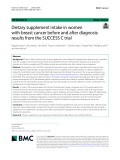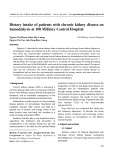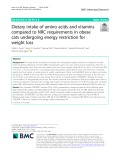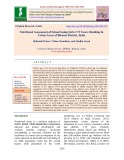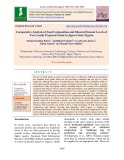
Dietary Recommended Intakes
-
There is little evidence that dietary supplements are beneficial for patients with breast cancer; therefore, they are usually not recommended by treatment guidelines. The aim of the present analysis was to assess the prevalence of dietary supplement (DS) intake among women before and after a breast cancer diagnosis.
 10p
10p  vishanshan
vishanshan
 27-06-2024
27-06-2024
 2
2
 1
1
 Download
Download
-
To describe the actual dietary intake in patients with end-stage chronic kidney disease on hemodialysis. Subject and method: Using the 24-hour recording method and comparing with the level that meets the recommended nutritional requirements.
 6p
6p  vilarry
vilarry
 12-03-2024
12-03-2024
 5
5
 2
2
 Download
Download
-
Micronutrient deficiency is a public health problem even though vegetable consumption could avert it. Vitamin C [Ascorbic acid (AA) and dehydroascorbate (DHAA)], β-carotene, lutein and vitamin B9 contents in seven traditional green leafy vegetables (raw and cooked) from Ghana were determined, to identify good sources and their potential contribution to Dietary Recommended Intakes.
 9p
9p  viisac
viisac
 23-09-2023
23-09-2023
 3
3
 1
1
 Download
Download
-
Lebanon, an Eastern Mediterranean country, is witnessing a remarkable nutrition transition, and the diets of school-aged children may be amongst those most affected. However, limited studies have examined the food consumption patterns and nutrient adequacy in this age group.
 18p
18p  viferrari
viferrari
 28-11-2022
28-11-2022
 5
5
 2
2
 Download
Download
-
Despite the known benefits of non-sedentary behavior, physical activity, and protein and caloric intake to health and muscle mass, strength, and function, many older adults do not meet physical activity and dietary recommendations. A better understanding of the factors associated with sedentary behavior, physical activity and dietary self-management behaviors, and muscle outcomes (muscle mass, strength, and function) is needed, particularly among continuing care retirement community residents.
 10p
10p  vinobelprisen
vinobelprisen
 26-03-2022
26-03-2022
 15
15
 6
6
 Download
Download
-
Adequate dietary protein intake is recommended for older adults to optimise muscle health and function, and support recovery from illness, however, its effect on health-related quality of life (HRQoL) is unclear. The aim of this study was to examine the association between total protein intake and different sources of dietary protein and HRQoL in Australians aged 60 years and older over a 12-year period.
 11p
11p  vinobelprisen
vinobelprisen
 26-03-2022
26-03-2022
 13
13
 6
6
 Download
Download
-
This study aimed to determine if obese cats undergoing energy restriction for weight loss would meet the National Research Council’s (NRC) indispensable amino acid and vitamin recommendations when fed a purpose-formulated diet.
 12p
12p  vigandhi
vigandhi
 23-02-2022
23-02-2022
 14
14
 1
1
 Download
Download
-
The role of nutritional factors or dietary elements is much more important which comprise balancing of energy between energy expenditure and intake or other factors that contribute to prevent obesity. Obesity is a noteworthy public health issue whose incidence tends to increase continuously. Emerging scientific data over the previous decade recommends that dairy foods might be advantageous when incorporated into a moderate energy limited diet and perhaps for weight management too.
 13p
13p  caygaocaolon3
caygaocaolon3
 09-03-2020
09-03-2020
 21
21
 2
2
 Download
Download
-
Children in the United States do not consume the recommended amounts of fruit. The economic and dietary consequences of meeting the shortfall in fruit consumption have not been evaluated.
 12p
12p  videshiki2711
videshiki2711
 21-02-2020
21-02-2020
 22
22
 1
1
 Download
Download
-
The experiment was conducted to determine the effects of four amino acids (lysine, methionine, threonine and tryptophan) supplementation on growth performances and serum antibody titers to Gumboro disease (IBD, infectious bursal disease) in broiler chickens. Chicks were randomly assigned to 5 dietary groups (5 chicks/group as 12 replicates of 5 chicks) in a complete randomised experimental design. Group I served as control group, was fed a diet without any supplementation.
 6p
6p  sabiendo
sabiendo
 02-01-2020
02-01-2020
 15
15
 1
1
 Download
Download
-
School age is the active growing phase of childhood. Primary school age ia a dynamic period of physical growth as well as of mental development of the child. Understanding the nutritional status of children has far reaching implications for the better development of future generations. The present study was undertaken to assess the nutritional status of 90 school going girls by assessing their general information, anthropometric measurements, and dietary assessment. Dietary assessment was done by 24 hour dietary recall method for three consecutive days.
 10p
10p  cothumenhmong1
cothumenhmong1
 11-12-2019
11-12-2019
 12
12
 0
0
 Download
Download
-
The aims of this study were to assess regional disparity in anemic status and to identify the sociodemographic factors associated with the prevalence of anemia among school-children from Punjab, India. A school-based cross-sectional study was conducted on 210 children (11-17y) randomly selected from government schools of three regions of Punjab, namely Majha (n=45), Doaba (n=45) and Malwa (n=120). Data on sociodemographic characteristics and dietary intake of children were collected through questionnaire based survey.
 16p
16p  cothumenhmong1
cothumenhmong1
 08-12-2019
08-12-2019
 21
21
 0
0
 Download
Download
-
The use of cereal grains as sources of food for man is well known. Different food products are obtained from grains based on the processing technique and the type of cereal employed. Although the causes of malnutrition are many and diverse, inadequate intake of foods and essential nutrients is a major contributory factor and yet this subject is poorly researched in many developing countries including Nigeria. This research was conducted in Jigawa State Nigeria. Were a total of 1,500 questionnaires were administered and 1,250 retrieved.
 11p
11p  nguaconbaynhay1
nguaconbaynhay1
 04-12-2019
04-12-2019
 29
29
 2
2
 Download
Download
-
taenoic acid, n-3) and DHA (Docosahexaenoic acid, n-3) cannot be synthesized by mammals and it must be provided as food supplement. ARA and DHA are the major PUFAs that constitute the brain membrane phospholipid. n-3 PUFAs are contained in fish oil and animal sources, while the n-6 PUFAs are mostly provided by vegetable oils. Inappropriate fatty acids consumption from the n-6 and n-3 families is the major cause of chronic diseases as cancer, cardiovascular diseases and diabetes.
 11p
11p  trinhthamhodang1
trinhthamhodang1
 14-11-2019
14-11-2019
 18
18
 1
1
 Download
Download
-
Chapter 2 presents the following content: Linking nutrients, foods, and health; dietary guidelines; exchange lists; recommendations for nutrient intake: the DRIs; food labels; claims that can be made for foods and dietary supplements.
 42p
42p  nomoney17
nomoney17
 04-07-2017
04-07-2017
 31
31
 4
4
 Download
Download
-
(BQ) This book presents the intake recommendations for fats and proteins for optimal yield; discusses the recommended proportions of carbohydrates to fats to proteins in the diet Addresses dietary fats and fatty acids, including omegas-3 and -6 and octacosonol; covers protein quality and quantity, protein supplements, and selected amino acid supplements; includes beneficial compounds such as glucosamine, chondroitin, and β-hydroxy-β-methylbutyrate.
 203p
203p  lalala03
lalala03
 17-11-2015
17-11-2015
 55
55
 3
3
 Download
Download
-
In this study they reported the number of patients who were adherent to the ADA diet recommendations and were able to achieve the recommended intakes of various types of fats. They found that levels of adherence to the recommendations was low with only 26.6% of patients consuming the recommended amount of saturated fatty acids (SFAs), 13.0% consuming the recommended ≥10% of dietary energy from polyunsaturated fats, and 38.5% consuming the recommended ≥60% of dietary energy from carbohydrates and monounsaturated fats. They also estimated that 46.
 35p
35p  dacotaikhoan
dacotaikhoan
 26-04-2013
26-04-2013
 80
80
 2
2
 Download
Download
-
Despite the long-established recommendations and public health messages, the population is still failing to achieve a healthy balanced diet. To date public health messages for dietary intakes have focused on the impact on health outcomes and have not addressed any of the wider issues relating to sustainability. It is recognised that this could be complex, but it is important to add some of the wider issues of sustainability into current dietary advice if a single, consistent message about the diet is to be given to the public, government and industry.
 62p
62p  ut_hai_can
ut_hai_can
 26-12-2012
26-12-2012
 51
51
 4
4
 Download
Download
-
In 2008 the Cabinet Office published Food Matters: Towards a Strategy for the 21st Century (Cabinet Office 2008), which set out some of the concerns about current food consumption in the UK and its impact on health, and the economic, social and environmental sustainability of food production. It concluded that the current diet is not sustainable for either public health or the environment. In brief, the diet of the UK population is failing to meet dietary recommendations, with high intakes of saturated fat, sugar and salt, and low intakes of fruit and vegetables (Henderson et al.
 77p
77p  ut_hai_can
ut_hai_can
 26-12-2012
26-12-2012
 61
61
 5
5
 Download
Download
-
To answer the first question, dietary intake data from the National Diet and Nutrition Survey (NDNS) for adults aged 19-64 years (2000/01) was compared with nutrient recommendations for health and the Eatwell plate. This confirmed the fact that the UK diet is too high in saturated fat, sugar and salt, and low in fibre compared with dietary recommendations. Furthermore, a shift to more fruit, vegetables and starch-based food and to fewer high fat and/or sugar types of food and high protein-based food (particularly meat) is needed.
 0p
0p  ut_hai_can
ut_hai_can
 26-12-2012
26-12-2012
 44
44
 3
3
 Download
Download
CHỦ ĐỀ BẠN MUỐN TÌM








